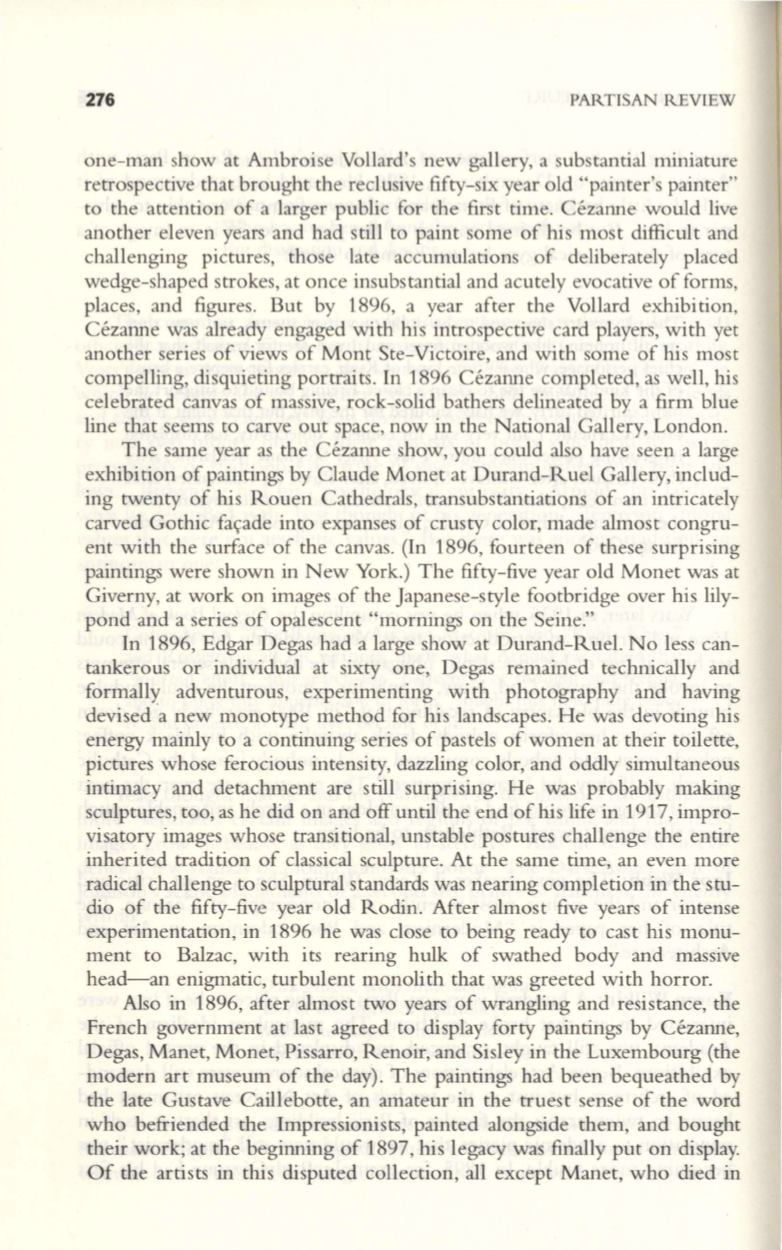
276
PARTISAN REVIEW
one-man show at Ambroise Vollard's new gallery, a substantial miniature
retrospective that brought the reclusive fifty-six year old "painter's painter"
to the attention of a larger public for the first time. Cezanne would live
another eleven years and had still to paint some of his most difficult and
challenging pictures, those late accumulations of deliberately placed
wedge-shaped strokes, at once insubstantial and acutely evocative of forms ,
places, and figures. But by 1896, a year after the Vollard exhibition,
Cezanne was already engaged with his introspective card players, with yet
another series of views of Mont Ste-Victoire, and wi th some of his most
compelling, disquieting portraits. In 1896 Cezanne completed, as well, his
celebrated canvas of massive, rock-solid bathers delineated by a firm blue
line that seems to carve out space, now in the National Gallery, London.
The same year as the Cezanne show, you could also have seen a large
exhibition of paintings by Claude Monet at Durand-Ruel Gallery, includ–
ing twenty of his Rouen Cathedrals, transubstantiations of an intricately
carved Gothic fayade into expanses of crusty color, made almost congru–
ent with the surface of the canvas. (In 1896, fourteen of these surprising
paintings were shown in New York.) The fifty-five year old Monet was at
Giverny, at work on images of the Japanese-style footbridge over his lily–
pond and a series of opalescent "mornings on the Seine."
In 1896, Edgar Degas had a large show at Durand-Rue\. No less can–
tankerous or individual at sixty one, Degas remained technically and
formally adventurous, experimenting with photography and having
devised ·a new mono type method for his landscapes. He was devoting his
energy mainly to a continuing series of pastels of women at their toilette,
pictures whose ferocious intensi ty, dazzling color, and oddly simultaneous
intimacy and detachment are still surprising. He was probably making
sculptures, too, as he did on and off until the end of his life in 1917, impro–
visatory images whose transitional, unstable postures challenge the entire
inherited tradition of classical sculpture. At the same time, an even more
radical challenge to sculptural standards was nearing completion in the stu–
dio of the fifty-five year old Rodin. Mter almost five years of intense
experimentation, in 1896 he was close to being ready to cast his monu–
ment to Balzac, wi th its rearing hulk of swathed body and massive
head-an enigmatic, turbulent monolith that was greeted with horror.
Also in 1896, after almost two years of wrangling and resistance, the
French government at last agreed to display forty paintings by Cezanne,
Degas, Manet, Monet, Pissarro, Renoir, and Sisley in the Luxembourg (the
modern art museum of the day). The paintings had been bequeathed by
the late Gustave Caillebotte, an amateur in the truest sense of the word
who befriended the Impressionists, painted alongside them, and bought
their work; at the beginning of 1897, his legacy was finally put on display.
Of the artists in this disputed collection, all except Manet, who died
in


